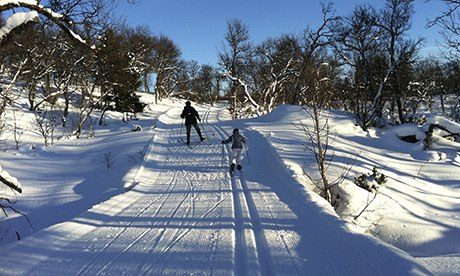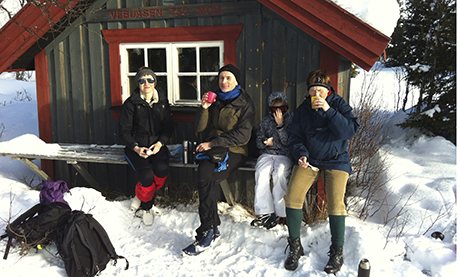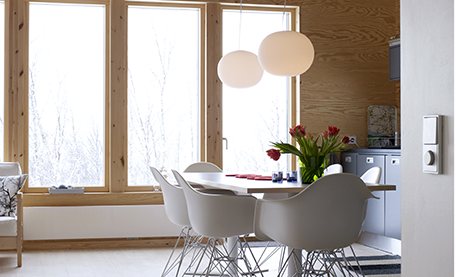
Maria’s son, Victor, and mother, Anna, on a cross-country trail. Photograph: Maria Westerståhl
‘It’s really all about speed, isn’t it?” My husband has come to a breathless stop beside me, at the bottom of the red Slalombacken slope in the resort of Ramundberget, close to the Norwegian border in western Sweden.
“I was on rails!” He beams, face flushed with adrenaline and wind-chill. It dawns on me that the moment has arrived. After a good decade of capable but stiffly cautious downhill skiing, my gracefully maturing life partner has unlocked the elusive secret of “the flow” – the exhilarating harmony of movement, gravity and control that we are on the slopes to pursue.
But the irony of the timing of my husband’s eureka moment is quite enjoyable in itself. This trip was conceived as an escape from the trappings and expense of downhill skiing. Ostensibly, we had had enough of the risks and thrills of the slope, and had come to the Funäsfjällen ski area to explore the vast and varied network of Nordic ski trails for which it is famous.
What you expect from Nordic, or cross-country, skiing is hours of hypnotic gliding through the stark, silent beauty of forest and fell, bathed in slanted light and interrupted only by the left-right swishy rhythm of effort and the occasional nod to a lone fellow enthusiast. This is the sport in its original form, pure and virtuous.
“Let’s do Slalombacken again,” shouts my husband over the din of the T-bar lift as it drags us towards the summit.
The truth is that we love both meditation and adrenaline, and that Funäsfjällen is the perfect place to have it all. Its five small downhill resorts are both exciting and manageable, and linked by 300km of beautifully prepared trails that comprise the Nordic Ski Centre – and a further 450km of marked touring trails.
Each resort offers enough for many days’ varied skiing, and a comprehensive lift pass gives access to the lot. A car-free week is possible, but it would involve some thought and planning as the ski-bus service between resorts is infrequent. For us, a group of six aged between two and 64, the week would have been a struggle without the 4×4 monster that brought us on the mountainous journey from Oslo. Either way, it’s sensible to choose a base to adventure from. We settled on Ramundberget, northernmost of the five, a low-key, friendly and well-established resort with offerings for all ages and inclinations.

Maria (left) and family take a hot chocolate break
The eponymous mountain rises like a whale out of a shallow forest sea, and though the slopes down its flanks are relatively short, so are the lift queues. Forest trails weave between ravines, black moguls and easy traverses. Toddlers learn the ropes on the gentle incline of LillRamis, while older children are well-looked-after in finely graded group lessons. Then families do lunchtime child swaps in the spacious warming hut, where packed lunches mingle with a basic hot food menu and toddlers jump on piles of jackets. (More refined options are available in the charming Fjällgården hotel, or in the striking circular Tusen – Thousand – restaurant near the summit.)
Cross-country novices can explore the gentle valley landscape before setting off on more adventurous highland trails. The summit waffle hut at Kariknallen is a good place to aim for, best reached via a ridgetop touring ski trail. For the faint of heart there is also a daily tow tractor.
For all the daytime options, there’s not much nightlife in Funäsfjällen, which is modelled on a well-established Swedish tradition of family skiing: self-catered chalets in quiet clusters among the trees. Revellers are better off a few hours north in Åre, Sweden’s most extensive and lively resort, where timber-slatted bars cater to a steady stream of urbanites.
More often than not, Swedish ski chalets are a bit anonymous and charmless, facilitators of a week’s inhabitation without excess or fuss. But PS Arkitektur, a small Stockholm-based architecture firm, is working to change that. We are luxuriating in a Fjällhuset (Fell House), one of a handful of types of simple, prefabricated barn-style chalet – with stylish wood and monochrome interiors – built here by the company.

The cool Fjällhuset interior
Deceptively simple in form, it is an understated declaration of love to the landscape that puts the extensive commercial competition to shame. And its location, a mere 20m from the nearest trail, is perfect – Fjällhuset will make you want to go cross-country skiing. As we watch dusk fall over the glowing mountains through the chalet’s picture window, we find the pull of a more subtle adventure gradually replacing the instant thrill of the slopes.
Our lift passes expired, we shove a grumbling toddler into a baby sleigh and get our anoraks on for a whole-family outing. The forecast is quite fierce, so we forgo the open fell and opt for a long loop around the forest’s edge in Ljusnedal, 20km to the south. The plan is to turn back early to prevent overexertion, but as the wind dissipates into an exquisite, sunny day, we are lulled into a hypnotic rhythm of movement. A singing eight-year-old leads our single file along the wavy edge of the high fell, and a gruelling final climb is rewarded by several thrilling miles of the gentle, wobbly descent so particular to Nordic skiing. In a race against the dark, we spend our last energies in a final sprint to the car.
It is impossible to know whether the first skis humans invented – they are thought to predate the wheel – instilled their users with the same collective unity of purpose and connection to the landscape: the notion of the sublime was more probably born of leisure than necessity. For their sake, though, I hope it did.
• Norwegian Airlines (norwegian.com) flies from Gatwick to Trondheim in Norway, about a three-hour drive from Funäsfjällen, from £57 return. A week at the Bruksvallarna 724 chalet, which sleeps seven, costs from £650. For bookings and information on ski passes, hire and lessons, call +46 684 15580 or visit funasfjallen.se/vinter/english